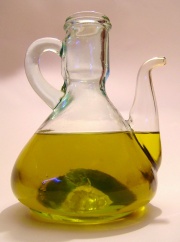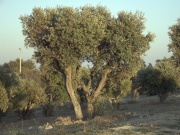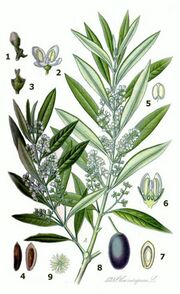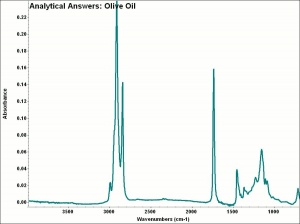Difference between revisions of "Olive oil"
Jump to navigation
Jump to search
m (Text replace - "\[http:\/\/cameo\.mfa\.org\/materials\/fullrecord\.asp\?name=([^\s]+)\s(.*)\]" to "$2") |
|||
| Line 1: | Line 1: | ||
[[File:Oliveoilvt.jpg|thumb|Olive oil]] | [[File:Oliveoilvt.jpg|thumb|Olive oil]] | ||
== Description == | == Description == | ||
| − | + | [[File:Olive-tree-F5.jpg|thumb|Olive tree ''Olea europaea'']] | |
A pale, greenish-yellow nondrying oil expressed from the fruit of the olive tree, ''Olea europaea''. Olive oil contains glycerides of [[oleic%20acid|oleic acid]] (56-83%), [[palmitic%20acid|palmitic acid]] (8-18%), [[linoleic%20acid|linoleic acid]] (4-19%), [[stearic%20acid|stearic acid]] (2-5%), [[linolenic%20acid|linolenic acid]] (0.3-1%) and arachidic acid (0.9%) with small amounts of squalene, phytosterol, and tocopherol (Serpico and White 2000). Olive oil has a delicate flavoring and is primary used for cooking. It becomes rancid on exposure to air and turns cloudy at cold temperatures. Olive oil has been used to dress leather. It is also used in the manufacture of [[castile%20soap|castile soap]], and textile lubricants. | A pale, greenish-yellow nondrying oil expressed from the fruit of the olive tree, ''Olea europaea''. Olive oil contains glycerides of [[oleic%20acid|oleic acid]] (56-83%), [[palmitic%20acid|palmitic acid]] (8-18%), [[linoleic%20acid|linoleic acid]] (4-19%), [[stearic%20acid|stearic acid]] (2-5%), [[linolenic%20acid|linolenic acid]] (0.3-1%) and arachidic acid (0.9%) with small amounts of squalene, phytosterol, and tocopherol (Serpico and White 2000). Olive oil has a delicate flavoring and is primary used for cooking. It becomes rancid on exposure to air and turns cloudy at cold temperatures. Olive oil has been used to dress leather. It is also used in the manufacture of [[castile%20soap|castile soap]], and textile lubricants. | ||
| − | + | [[File:Tafelneuolive4f5.jpg|thumb|Olive tree ''Olea europaea'']] | |
| − | [[File: | ||
| − | |||
| − | ''Olea europaea'']] | ||
== Synonyms and Related Terms == | == Synonyms and Related Terms == | ||
| Line 13: | Line 10: | ||
[[[SliderGallery rightalign|aaiOLIVEOIL.jpg~FTIR]]] | [[[SliderGallery rightalign|aaiOLIVEOIL.jpg~FTIR]]] | ||
| − | == | + | == Risks == |
| + | |||
| + | * Combustible. Flash point = 225 C. | ||
| + | * Contact may cause irritation. | ||
| + | * Fisher Scientific: [https://fscimage.fishersci.com/msds/96356.htm MSDS] | ||
| − | + | == Physical and Chemical Properties == | |
| − | Soluble in ether, chloroform and carbon disulfide. | + | * Saponification value = 187-196 |
| + | * Iodine value = 79-90; | ||
| + | * Soluble in ether, chloroform and carbon disulfide. | ||
{| class="wikitable" | {| class="wikitable" | ||
| Line 25: | Line 28: | ||
|- | |- | ||
! scope="row"| Melting Point | ! scope="row"| Melting Point | ||
| − | | -6.0 | + | | -6.0 C |
|- | |- | ||
! scope="row"| Density | ! scope="row"| Density | ||
| − | | 0.910-.918 | + | | 0.910-.918 g/ml |
|- | |- | ||
! scope="row"| Refractive Index | ! scope="row"| Refractive Index | ||
| Line 34: | Line 37: | ||
|} | |} | ||
| − | == | + | ==Resources and Citations== |
| − | |||
| − | |||
| − | |||
| − | |||
| − | |||
| − | |||
| − | |||
| − | |||
| − | |||
| − | |||
| − | |||
| − | |||
| − | |||
| − | |||
| − | |||
| − | |||
| − | |||
* ''The Merck Index'', Martha Windholz (ed.), Merck Research Labs, Rahway NJ, 10th edition, 1983 Comment: entry 6973 | * ''The Merck Index'', Martha Windholz (ed.), Merck Research Labs, Rahway NJ, 10th edition, 1983 Comment: entry 6973 | ||
Latest revision as of 12:16, 20 August 2022
Description
A pale, greenish-yellow nondrying oil expressed from the fruit of the olive tree, Olea europaea. Olive oil contains glycerides of Oleic acid (56-83%), Palmitic acid (8-18%), Linoleic acid (4-19%), Stearic acid (2-5%), Linolenic acid (0.3-1%) and arachidic acid (0.9%) with small amounts of squalene, phytosterol, and tocopherol (Serpico and White 2000). Olive oil has a delicate flavoring and is primary used for cooking. It becomes rancid on exposure to air and turns cloudy at cold temperatures. Olive oil has been used to dress leather. It is also used in the manufacture of Castile soap, and textile lubricants.
Synonyms and Related Terms
Olea europaea; huile d'olive (Fr.); aceite de oliva (Esp.); olio di oliva (It)
Risks
- Combustible. Flash point = 225 C.
- Contact may cause irritation.
- Fisher Scientific: MSDS
Physical and Chemical Properties
- Saponification value = 187-196
- Iodine value = 79-90;
- Soluble in ether, chloroform and carbon disulfide.
| CAS | 8001-25-0 |
|---|---|
| Melting Point | -6.0 C |
| Density | 0.910-.918 g/ml |
| Refractive Index | 1.466-1.468 |
Resources and Citations
- The Merck Index, Martha Windholz (ed.), Merck Research Labs, Rahway NJ, 10th edition, 1983 Comment: entry 6973
- Richard S. Lewis, Hawley's Condensed Chemical Dictionary, Van Nostrand Reinhold, New York, 10th ed., 1993
- Hermann Kuhn, Conservation and Restoration of Works of Art and Antiquities, Butterworths, London, 1986
- A.Lucas, J.R.Harris, Ancient Egyptian Materials and Industries, Edward Arnold Publishers Ltd., London, 4th edition, 1962
- Ancient Egyptian Materials and Technologies, Paul Nicholson, Ian Shaw (eds.), Cambridge University Press, Cambridge, 2000 Comment: M.Serpico, R.White, "Oil, fat and wax"
- Art and Architecture Thesaurus Online, http://www.getty.edu/research/tools/vocabulary/aat/, J. Paul Getty Trust, Los Angeles, 2000
- CRC Handbook of Chemistry and Physics, Robert Weast (ed.), CRC Press, Boca Raton, Florida, v. 61, 1980 Comment: melting point = -6.0, density=0.918, ref. index = 1.4679, iodine value=81.1, saponification value = 189.7



